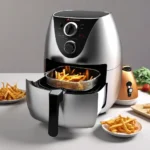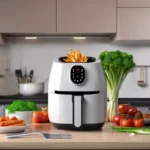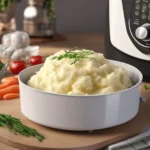Originally posted on 12 August 2023 @ 20:45
Does An Air Fryer Use More Electricity Than A Microwave?
The endearing microwave still has some tricks up its sleeve! Sure, it’ll randomly, and rather efficiently, heat all your leftovers in seconds, but it really is great when you do a bulk cooking thing.
So if you have only a handful of family members, you have no reason to get rid of the microwave just for reheating and cooking one serving. For every guest or meal prep, use your air fryer.
And with a bit of insight, both ovens could very well be well-utilized to you keeping your entire food sumptuous while still being mindful of the utility bills! Before you know it, you may have become an energy efficiency expert! At last, just kick back and reward yourself with those crispy air-fried wings!
How Do Air Fryers Work Their Magic?
Air fryers are tiny convection ovens. A heating coil and a fan circulate hot air around the food at high speed to cook it fast. Air frying creates a nice crispy texture similar to deep frying but without all the oil.
Most air fryers have temperature dials up to 400°F and timers to set the cooking time. Popular models from Philips, Cosori, and Instant hold 3-5 quarts of food.
Microwaves Use Radiation to Cook
Electromagnetic energy is generated in the microwave oven. It isn’t a simple affair, but the oven’s tendency to do work can be understood in terms of what’s called the “electric dipole moment.” Water in food has a very large electric dipole moment. This large moment makes water molecules a good target for the kind of energy that’s provided by a microwave oven.
Microwaves can only penetrate about an inch deep though. That’s why there’s a turntable – to help cook more evenly. Power levels go from 500-1200 watts and they have timers too. Basic microwaves fit 0.5-2 cubic feet of food.
How Much Juice Do Air Fryers Use?
Most air fryers need 1200-1500 watts of power. But here’s the thing – they don’t run full blast the whole time you’re cooking. Air fryers cycle on and off. They’ll turn on to preheat, then go off while cooking with residual heat.
The average power draw is more realistically 700-1000 watts. To cook a batch of food, air fryers use 800-1500 watt-hours.
Microwaves Use Full Power Constantly
Microwaves are rated at 1000-1200 watts typically. And they use that full power the entire cooking time. So if you zap something for 5 minutes in a 1000-watt microwave, it’s using about 5000-watt hours of electricity.
For a small 1-2 person meal, expect 500-1000 watt-hours used. More for baking, less for quick reheating. Using lower power settings can reduce electricity usage.
Comparing Electricity Costs
Price Review on the Electric Bills. Air fryers take about 800–1600 watt-hours per cook.
The microwave can use 500-1000 watt-hours of electricity, though more often than not closer to the lower end. Well, almost everyone knows that the median price of electricity per kW/ h in America is 12 cents US$ and this makes it means $0.udenticons — (1)$3 per meal cooked by an air fryer The same food costs 6-12 cents to heat up in the microwave.
Proved that, when you are preparing a large amount of food air fryers perform better. This is because these can be cooked in greater amounts at once. If you were to air fry your four chicken breasts at that rate, requiring 1500 watt-hours in the process, it would cost about 18 cents.
What Affects Energy Use?
Lots of factors determine how much power air fryers and microwaves use:
- Wattage: More watts equals more electricity.
- Cooking time: Longer cooking times use more energy.
- Quantity: Bigger portions use more power.
- Function: Reheating vs. baking changes energy needs.
- Power settings: Lower microwave settings save energy.
- Batch cooking: Staggered cooking wastes energy.
- Efficiency: Newer models use less energy.
- Air fryer cycling: On/off intervals affect electricity usage.
- Manual preheating: Don’t do it! Uses extra electricity.
Tips for Saving Power
Here are some ways to use your air fryer or microwave more efficiently:
- Cook more food at once when possible – maximize that energy!
- Skip preheating unless you have to – just delays cooking.
- Use lower microwave power levels when you can.
- Cook multiple items together in the microwave.
- Set timers and don’t open the door until time’s up!
- Match appliance size to portion size.
- Clean your appliances for maximum efficiency.
- Unplug when not in use to prevent standby power draw.
- Consider lower wattage models to save energy.
- Follow manufacturer guidelines for optimal settings.
Key Takeaways:
- Air fryers spend more watts of electricity per meal than microwaves.
- Microwaves are the best for quickly reheating individual servings.
- Air fryers are more efficient than microwave ovens for more extensive households needing to cook more servings at a go.
- Both appliances could cook delicious meals and help save energy and money in no time for you with some easy adjustments.
FAQs
Does an air fryer use more electricity than a regular oven?
You betcha. Air fryers need more power than a full-size oven because of the fan circulating the hot air. Ovens are more efficient for larger batches.
Should I get a more powerful air fryer or microwave?
I’d stick to average wattages unless you need lightning-fast cooking. Higher watts mean higher electricity bills!
For a family of 4, what’s more energy efficient?
Air fryers for the win! You can cook more servings at once instead of reheating them multiple times in the microwave.
What’s cheaper for meal prepping – an air fryer or a microwave?
Microwaves are great for quickly reheating individual portions. But air fryers let you cook full meals for the week more efficiently.
Should I preheat my air fryer before cooking?
Don’t bother! Preheating just wastes electricity unless it’s totally necessary for what you’re cooking.
Conclusion
Air fryers and microwaves both have their advantages at last. An air fryer crisps up the food while retaining the fried taste but takes up more electric energy per meal. A microwave heats leftovers in one flash but doesn’t cook in large batches effectively.
For small families, there is no reason to dismiss a microwave just for reheating and cooking single servings. Use the air fryer once you have a crowd of guests or want to meal prep.
With just a little insight, both ovens could be utilized to keep your food sumptuous while maintaining a low energy bill! Very soon, you might just become an energy efficiency expert! Now just relax and reward yourself with those crispy air-fried wings!

I’m Ian Welkins, a seasoned professional in the kitchen industry. My passion now drives me to provide invaluable insights into the world of top-notch kitchen products. With years of hands-on experience, I’m your go-to source for culinary excellence.










